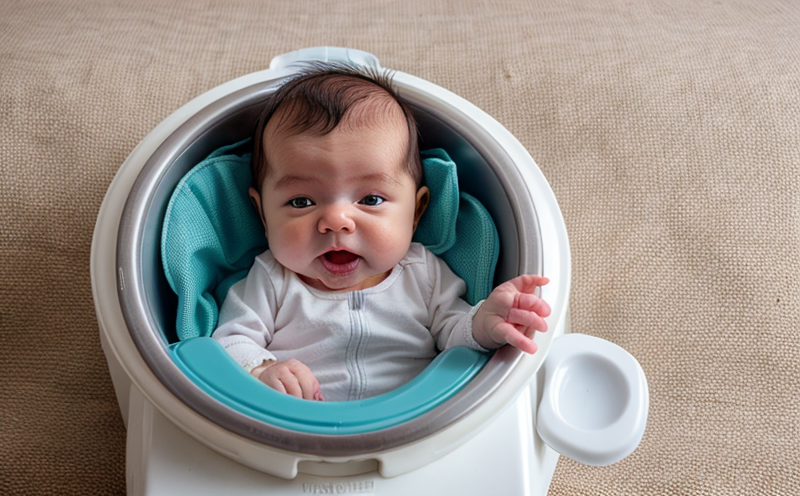Heat Deflection Temperature Under Load Test
The heat deflection temperature under load (HDTUL) is a critical parameter used to evaluate the thermal and mechanical properties of plastic materials, particularly in applications where components are subjected to both temperature and load stress. In infant formula and baby food packaging, HDTUL testing ensures that containers can withstand high temperatures during sterilization processes without deforming or losing structural integrity.
This test is essential for quality managers and compliance officers as it helps ensure product safety and reliability by identifying materials capable of withstanding the rigors of manufacturing and use. For R&D engineers and procurement professionals, HDTUL testing provides insights into material performance under stress conditions, facilitating informed decisions about material selection and process optimization.
The test involves subjecting a specimen to a specified load over a defined temperature range until it deflects by a set distance or fails completely. The temperature at which this occurs is recorded as the heat deflection temperature. This parameter is crucial for assessing the suitability of plastic materials in food packaging, ensuring that they remain stable and safe under expected usage conditions.
For instance, during the sterilization process, infant formula containers must be able to withstand temperatures up to 120°C without losing their shape or integrity. By conducting HDTUL tests, manufacturers can ensure that their products meet these stringent requirements, thereby protecting consumer safety and maintaining brand reputation.
The testing procedure follows ISO standards, ensuring consistency and reliability across different laboratories. The specimen is typically a thin bar of the material in question, clamped at one end and subjected to a load at the other. Temperature is gradually increased while monitoring deflection until failure occurs.
Understanding HDTUL values helps quality managers set realistic expectations for product performance and compliance officers ensure adherence to regulatory standards. For R&D engineers, this test provides valuable data on material behavior under stress conditions, enabling them to innovate and improve product design.
In summary, the heat deflection temperature under load test is a vital tool in ensuring the safety, reliability, and quality of infant formula and baby food packaging. By accurately measuring how materials perform under specific environmental stresses, this testing method supports informed decision-making throughout the product lifecycle.
Scope and Methodology
The heat deflection temperature under load test is conducted in accordance with ISO 75-1:2003 (Plastics — Determination of load deflection temperature). This standard specifies the procedure for determining the heat deflection temperature, which is defined as the lowest temperature at which a sample deformed by a specified bending moment breaks.
The test involves using a universal testing machine equipped with a heating chamber. A specimen bar made from the material to be tested is clamped in the fixture of the machine. The specimen is then subjected to a standard load (typically 1.8 kgf/cm²) and heated at a controlled rate, usually between 25°C and 100°C per hour.
- Test Specimen: Typically a flat or rectangular bar measuring about 6 mm x 12 mm x 127 mm (±0.3 mm).
- Loading Condition: A load of 1.8 kgf/cm² is applied to the free end of the specimen.
- Heating Rate: The temperature should be raised at a rate not exceeding 10°C per minute.
The test continues until the specimen deflects by 0.2 mm under the specified load or breaks. The temperature reading at this point is recorded as the heat deflection temperature (HDT). This value provides valuable information about the material's thermal and mechanical properties, which are crucial for ensuring product safety and performance.
The test results are reported in accordance with the ISO standard, detailing the specimen dimensions, loading conditions, heating rate, and the HDT value. These data points allow for consistent evaluation of materials across different manufacturers and laboratories, facilitating quality assurance and regulatory compliance.
Industry Applications
- Medical Devices: Ensuring that components used in medical devices can withstand sterilization processes without deformation or failure.
- Consumer Goods: Evaluating the durability of packaging materials for food and beverages, ensuring they remain intact under high temperature conditions.
- Aerospace: Assessing material performance for parts that are exposed to extreme temperatures during manufacturing and use.
In infant formula and baby food testing, HDTUL is particularly important for packaging materials. It ensures that containers can withstand the heat of sterilization without losing structural integrity or releasing harmful chemicals into the product. This is crucial for maintaining both the safety and quality of the product throughout its shelf life.
For manufacturers, knowing the HDTUL value helps in selecting appropriate materials that meet regulatory requirements and ensure consistent performance across different products. This testing method provides valuable insights into material behavior under stress conditions, enabling informed decisions about product design and manufacturing processes.
Customer Impact and Satisfaction
- Enhanced Safety: Ensures that packaging materials do not deform or release harmful substances during sterilization, protecting the integrity of infant formula and baby food products.
- Improved Quality Assurance: Provides consistent data on material performance, allowing for better quality control throughout the manufacturing process.
- Regulatory Compliance: Ensures that products meet all relevant standards and regulations, enhancing consumer confidence in the brand's commitment to safety.
By ensuring that packaging materials meet HDTUL requirements, manufacturers can significantly improve customer satisfaction. Consumers are reassured knowing that their babies' food is protected by safe, durable containers that have been rigorously tested for performance under high-temperature conditions. This enhances the reputation of brands committed to quality and safety.
Moreover, HDTUL testing helps in reducing waste and improving resource efficiency by selecting materials that perform well under expected usage conditions. This reduces the likelihood of product failures and recalls, further enhancing customer satisfaction and brand loyalty.





